We often hear that computers are automatically upgrading to Windows 10 without the computer users knowledge or consent.
Here are just a few messages that appeared on Facebook over the weekend with the identities and expletives removed. You can see the frustration of the Windows users.
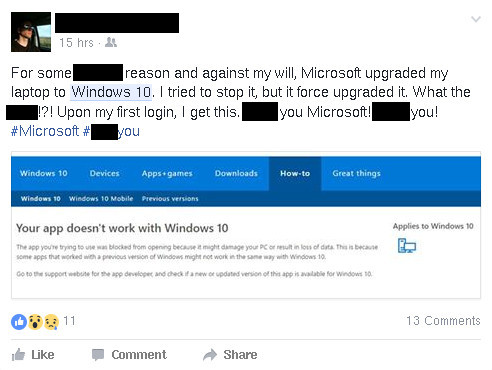
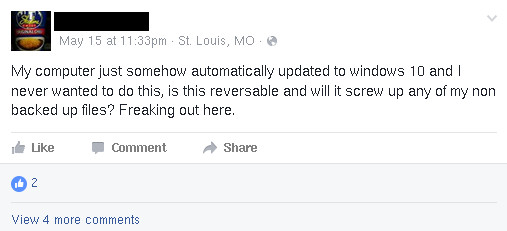
At first we thought maybe people were confused by the recommended Windows 10 upgrade message and maybe accidentally clicked to initiate the upgrade, until we noticed the computers for sale here at South City Computer started showing a message indicating that Windows was going to upgrade to Windows 10 automatically. What Microsoft?!?! We didn’t ask or agree to upgrade to Windows 10!
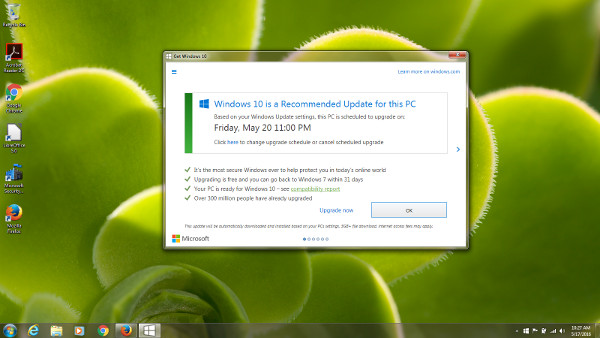
As you can see, Windows is set to automatically upgrade to Windows 10 on May 20th for this computer. Even though we have ignored the pop-ups urging us to upgrade to Windows 10 for months now, we are going to be upgraded unless we take action!
So here is how to cancel this force upgrade. Do NOT click OK, instead click on the word “here” where it says “Click here to change upgrade schedule or cancel scheduled upgrade”.
The next screen you should see is as follows:
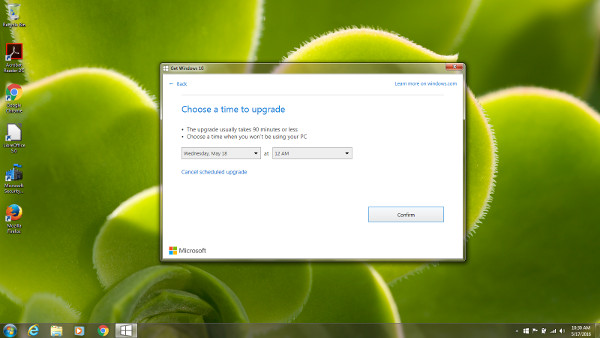
Next click “Cancel scheduled upgrade”.
After this you will see the next message:
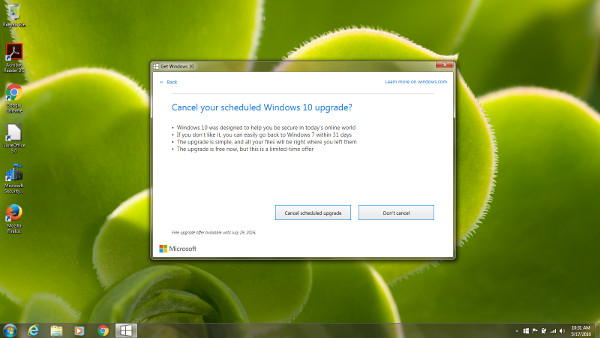
Again, Microsoft wants to be very sure that we want to seriously Cancel the automatic upgrade to Windows 10. Now click the “Cancel Scheduled Upgrade” button.
After you do this, it should cancel the automatic upgrade that was set for May 20th. If you do not go through this process, then you will be forced into Windows 10. If you want to eliminate the Windows 10 upgrade completely forever, bring your computer to South City Computer and we will disable the Windows 10 upgrade for good!

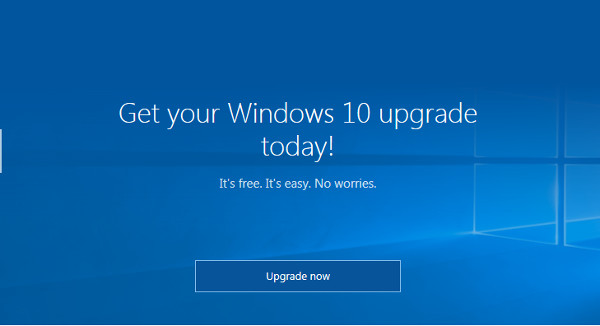 The FREE Windows 10 upgrade offer is set to expire on July 29, 2016. After the free Windows 10 upgrade expires Windows users will still be able to upgrade, but will have to pay for the new version of Windows.
The FREE Windows 10 upgrade offer is set to expire on July 29, 2016. After the free Windows 10 upgrade expires Windows users will still be able to upgrade, but will have to pay for the new version of Windows.  Keep your computer system up to date. Run updates regularly and also have a running up-to-date anti-virus software if you are using Windows. Never allow your anti-virus software become out of date. Newer and better malware and computer viruses are released on the Internet every day.
Keep your computer system up to date. Run updates regularly and also have a running up-to-date anti-virus software if you are using Windows. Never allow your anti-virus software become out of date. Newer and better malware and computer viruses are released on the Internet every day.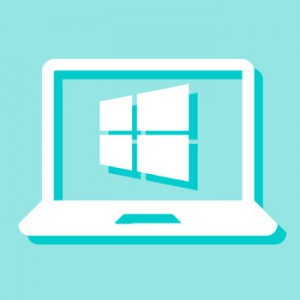 The free Windows 10 product key works very differently from previous versions Windows. In the past the product key would always serve to activate your copy of Windows. However if you upgraded to Windows 10 from a previous version of Windows then you probably never received a product key for Windows 10. Since a Windows 10 update released in November it may be possible to use your previous Windows 7 or Windows 8.1 product key to activate Windows 10. But, basically the Windows 10 upgraders just don’t have a product key.
The free Windows 10 product key works very differently from previous versions Windows. In the past the product key would always serve to activate your copy of Windows. However if you upgraded to Windows 10 from a previous version of Windows then you probably never received a product key for Windows 10. Since a Windows 10 update released in November it may be possible to use your previous Windows 7 or Windows 8.1 product key to activate Windows 10. But, basically the Windows 10 upgraders just don’t have a product key. 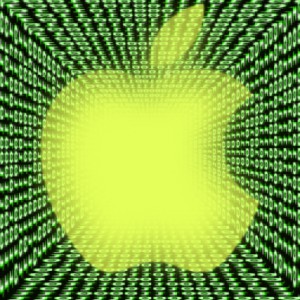 Apple computers are not immune to malware vulnerabilities. A new form of malware called “ransomware” is targeting Apple’s Mac OS X operating system. Ransomeware is a computer virus that encrypts important data such as pictures, videos, music, and documents in order to “hold it for ransom” at an unsuspecting victim’s expense. If the victim pays the ransom then, hopefully, they would receive a key to decrypt their data, known as a decryption key. Unfortunately many times there is no decryption key and the victim loses not only their data but possibly up to $700 USD in ransom payment. The ransom payment transaction occurs using an anonymous payment method in order to conceal the identity of the scammer holding the data ransom so that there is no trace. Ransomware is usually spread via email attachments, peer to peer file sharing, and more recently removable devices such as external hard drives and USB flash drives.
Apple computers are not immune to malware vulnerabilities. A new form of malware called “ransomware” is targeting Apple’s Mac OS X operating system. Ransomeware is a computer virus that encrypts important data such as pictures, videos, music, and documents in order to “hold it for ransom” at an unsuspecting victim’s expense. If the victim pays the ransom then, hopefully, they would receive a key to decrypt their data, known as a decryption key. Unfortunately many times there is no decryption key and the victim loses not only their data but possibly up to $700 USD in ransom payment. The ransom payment transaction occurs using an anonymous payment method in order to conceal the identity of the scammer holding the data ransom so that there is no trace. Ransomware is usually spread via email attachments, peer to peer file sharing, and more recently removable devices such as external hard drives and USB flash drives.  A recent plethora of reports of stolen credit card numbers in the St. Louis metro area has led authorities, banks, and credit and debit card customers on a wild goose chase to recover their stolen funds. The cards numbers were “lifted” using credit card “skimmers” that were inserted into several metro area gas station pumping machines. A credit card skimmer is a computer device small enough to be inserted into a credit card reader that has it’s own credit card stripe reader and usually some sort of radio or Bluetooth device to transmit the information to another computer in order to commit credit card fraud.
A recent plethora of reports of stolen credit card numbers in the St. Louis metro area has led authorities, banks, and credit and debit card customers on a wild goose chase to recover their stolen funds. The cards numbers were “lifted” using credit card “skimmers” that were inserted into several metro area gas station pumping machines. A credit card skimmer is a computer device small enough to be inserted into a credit card reader that has it’s own credit card stripe reader and usually some sort of radio or Bluetooth device to transmit the information to another computer in order to commit credit card fraud. 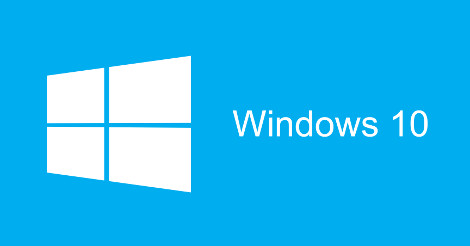 If you don’t currently have Windows 10, you are likely getting pop-ups urging you to upgrade. However, you may want to think twice before you do. Unfortunately, in the short time it’s been available, it has shown itself to be simply not the best option for everyone. If you’re system is currently running Windows 8/8.1, you may be able to make the transition with only minor headaches… Maybe. But if your system is currently running Windows 7, upgrading to Window’s 10 will probably end up being way more trouble than it’s worth.
If you don’t currently have Windows 10, you are likely getting pop-ups urging you to upgrade. However, you may want to think twice before you do. Unfortunately, in the short time it’s been available, it has shown itself to be simply not the best option for everyone. If you’re system is currently running Windows 8/8.1, you may be able to make the transition with only minor headaches… Maybe. But if your system is currently running Windows 7, upgrading to Window’s 10 will probably end up being way more trouble than it’s worth. 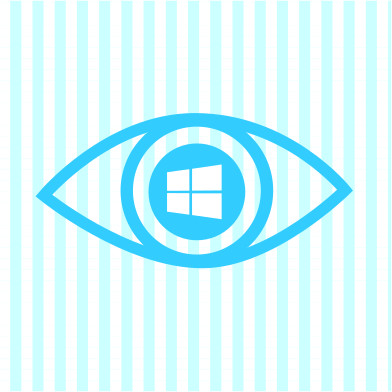 Did you know that Microsoft Windows 10 shares information with Microsoft about your computer usage? Likely if you have gone through the Windows 10 upgrade or installed Windows 10 onto your computer you might still need to set up your privacy settings.
Did you know that Microsoft Windows 10 shares information with Microsoft about your computer usage? Likely if you have gone through the Windows 10 upgrade or installed Windows 10 onto your computer you might still need to set up your privacy settings.
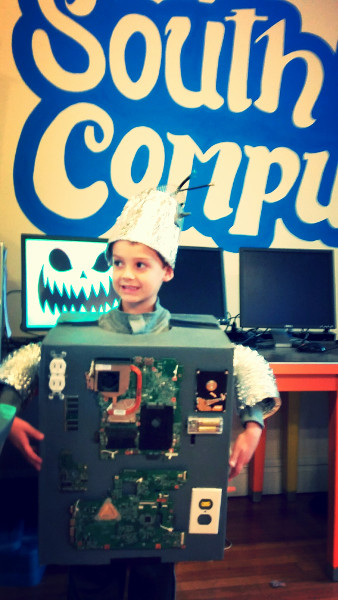 About a month ago a customer came to South City Computer asking for some old computer parts that she could give to her son, Sam, so that he could create a Halloween costume. Sam and his father came by the South City Computer repair store today to show off Sam’s Halloween costume creation. Sam created a robot costume using the recycled computer parts and is complete with functional LED lights and a robot rocket-pack on the back. Sam’s Halloween Robot costume was made possible by using computer parts that South City Computer customers have recycled. Thanks to Sam and his parents for the creative use of recycled computer technology with Halloween.
About a month ago a customer came to South City Computer asking for some old computer parts that she could give to her son, Sam, so that he could create a Halloween costume. Sam and his father came by the South City Computer repair store today to show off Sam’s Halloween costume creation. Sam created a robot costume using the recycled computer parts and is complete with functional LED lights and a robot rocket-pack on the back. Sam’s Halloween Robot costume was made possible by using computer parts that South City Computer customers have recycled. Thanks to Sam and his parents for the creative use of recycled computer technology with Halloween.